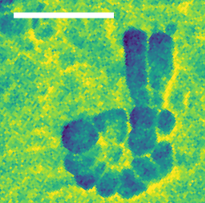IRIS beamline at BESSY II extended with nanomicroscopy

Infrared image of the nucleolus in the nucleus of a fibroblast cell. The scale bar corresponds to 500 nanometres. © HZB
The IRIS infrared beamline at the BESSY II storage ring now offers a fourth option for characterising materials, cells and even molecules on different length scales. The team has extended the IRIS beamline with an end station for nanospectroscopy and nanoimaging that enables spatial resolutions down to below 30 nanometres. The instrument is also available to external user groups.
The infrared beamline IRIS at the BESSY II storage ring is the only infrared beamline in Germany that is also available to external user groups and is therefore in great demand. Dr Ulrich Schade, in charge of the beamline, and his team continue to develop the instruments to enable unique, state-of-the-art experimental techniques in IR spectroscopy.
As part of a recent major upgrade to the beamline, the team, together with the Institute of Chemistry at Humboldt University Berlin, has built an additional infrared near-field microscope.
"With the nanoscope, we can resolve structures smaller than a thousandth of the diameter of a human hair and thus reach the innermost structures of biological systems, catalysts, polymers and quantum materials," says Dr Alexander Veber, who led this extension.
The new nanospectroscopy end station is based on a scanning optical microscope and enables imaging and spectroscopy with infrared light with a spatial resolution of more than 30 nm. To demonstrate the performance of the new end station, Veber analysed individual cellulose microfibrils and imaged cell structures. All end stations are available to national and international user groups.
Funding information: Bundesministerium für Bildung und Forschung [grant No. project 05K19KH1 (SyMS)]; Germany's Excellence Strategy (grant No. EXC 2008-390540038 – UniSysCat).
arö
https://www.helmholtz-berlin.de/pubbin/news_seite?nid=26746;sprache=en
- Copy link
-
The future of corals – what X-rays can tell us
This summer, it was all over the media. Driven by the climate crisis, the oceans have now also passed a critical point, the absorption of CO
2 is making the oceans increasingly acidic. The shells of certain sea snails are already showing the first signs of damage. But also the skeleton structures of coral reefs are deteriorating in more acidic conditions. This is especially concerning given that corals are already suffering from marine heatwaves and pollution, which are leading to bleaching and finally to the death of entire reefs worldwide. But how exactly does ocean acidification affect reef structures?
Prof. Dr. Tali Mass, a marine biologist from the University of Haifa, Israel, is an expert on stony corals. Together with Prof. Dr. Paul Zaslansky, X-ray imaging expert from Charité Berlin, she investigated at BESSY II the skeleton formation in baby corals, raised under different pH conditions. Antonia Rötger spoke online with the two experts about the results of their recent study and the future of coral reefs.
-
Long-term stability for perovskite solar cells: a big step forward
Perovskite solar cells are inexpensive to produce and generate a high amount of electric power per surface area. However, they are not yet stable enough, losing efficiency more rapidly than the silicon market standard. Now, an international team led by Prof. Dr. Antonio Abate has dramatically increased their stability by applying a novel coating to the interface between the surface of the perovskite and the top contact layer. This has even boosted efficiency to almost 27%, which represents the state-of-the-art. After 1,200 hours of continuous operation under standard illumination, no decrease in efficiency was observed. The study involved research teams from China, Italy, Switzerland and Germany and has been published in Nature Photonics.
-
Energy of charge carrier pairs in cuprate compounds
High-temperature superconductivity is still not fully understood. Now, an international research team at BESSY II has measured the energy of charge carrier pairs in undoped La₂CuO₄. Their findings revealed that the interaction energies within the potentially superconducting copper oxide layers are significantly lower than those in the insulating lanthanum oxide layers. These results contribute to a better understanding of high-temperature superconductivity and could also be relevant for research into other functional materials.
